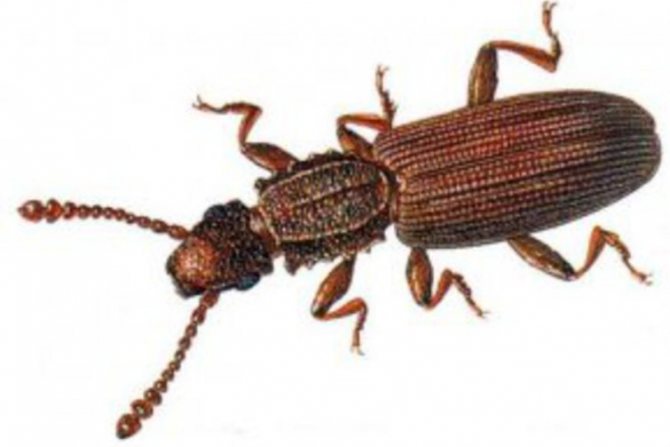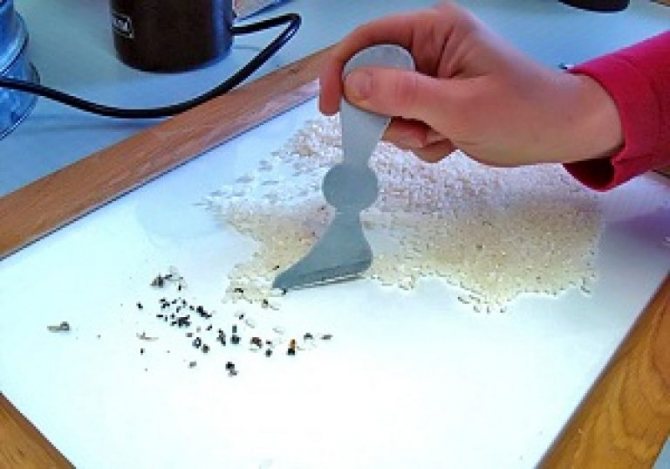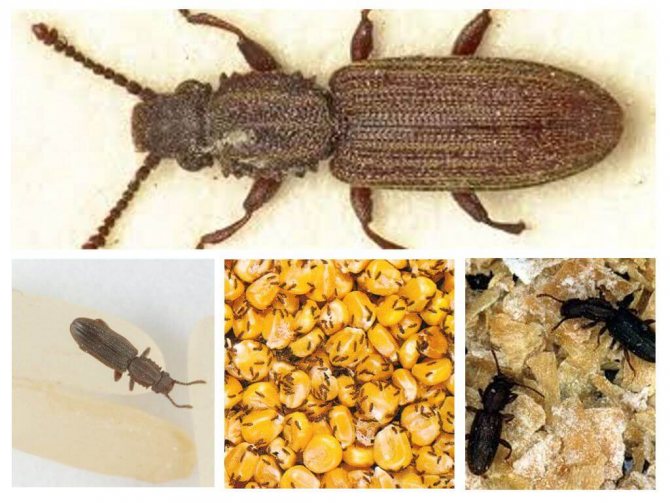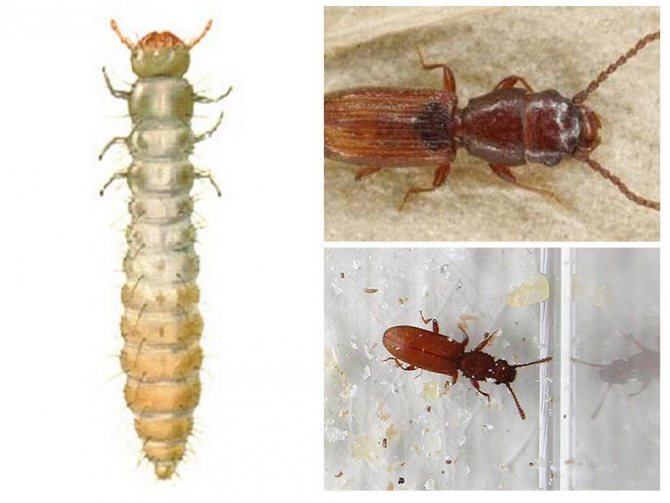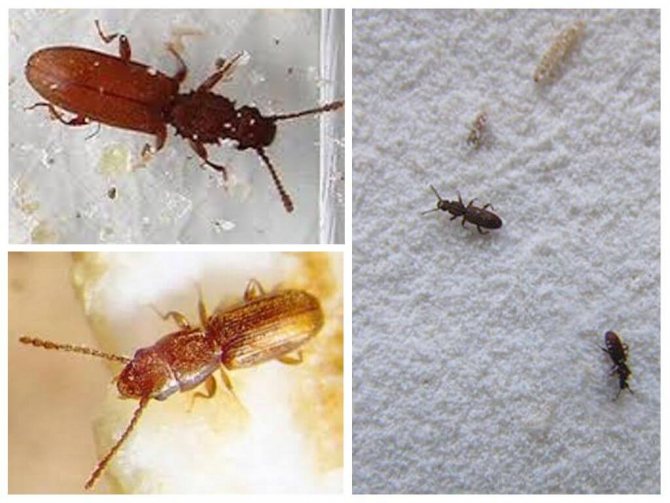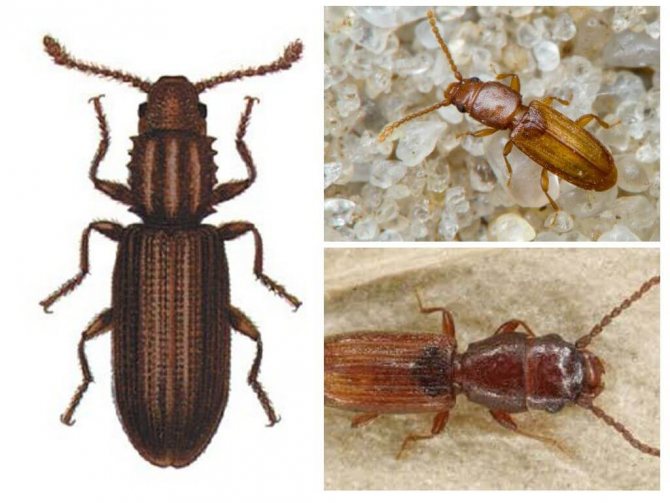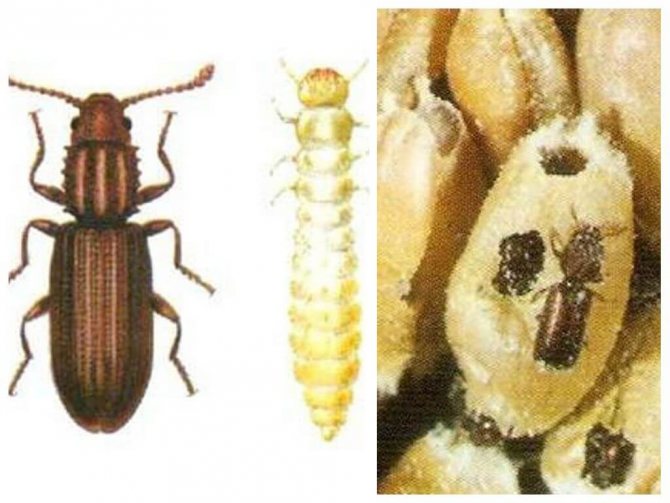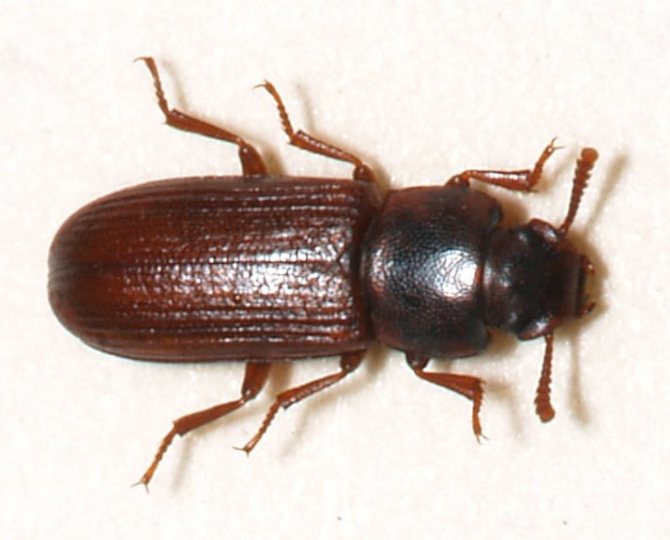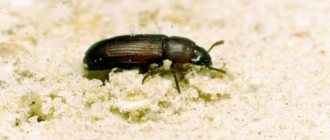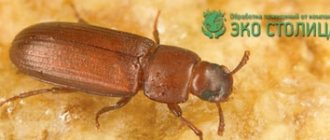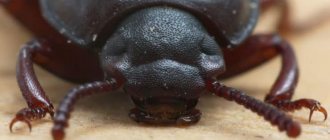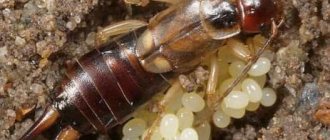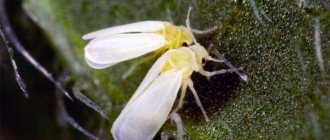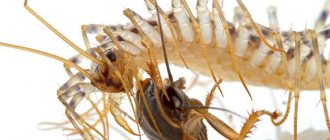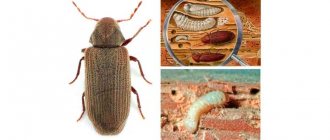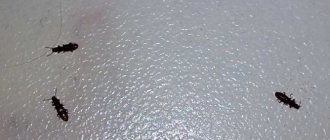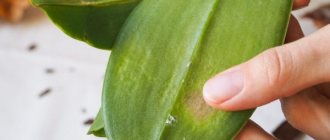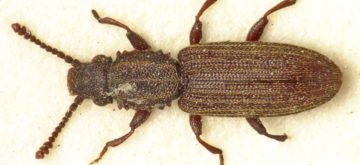
The Surinamese mucoed is a small pest that chooses bulk foodstuffs, mainly cereals, for settlement and reproduction. Surinamese mucoid - how to get rid of it?
The insect has a dark brown or black body, the length of which usually does not exceed 4 mm, so it can be very difficult to notice such a bug. Shows how muco-eaters look like, the photo below.
The ginger subspecies of this insect is distinguished by an unpleasant rusty tint of the body. It is half the size of the Surinamese bug.
The ginger flour eater loves to settle in flour, dried fruits, corn grits. Often this pest does not hesitate to feed for animals.
To see, and even more so to recognize with the naked eye, a beetle is even more difficult than its black counterpart, due to its tiny size... You can see the red-haired muco-eater in the photo.
Description of the insect. What does the Surinamese muco-eater eat?
There are several stages in the development of a beetle: an egg, a larva, a pupa, an adult. Once in flour or cereal, the beetle begins an active life. Adults and their larvae feed on husks, feces, and other debris. The Surinamese flour eater can damage a variety of food products: grains, flour, cereals, confectionery, dried vegetables and fruits, oilseeds, nuts, etc.
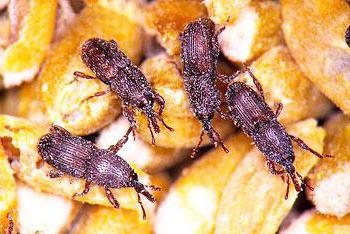

The life span of the mucoed is about three years, during which it lays 100-600 eggs. For one clutch, 20-30 eggs are born, which in 1-2.5 months will become adult beetles. If the conditions for the muco-eater are the best, such as a temperature of 25-27 degrees and a humidity of 65%, then the reproduction rate will be maximum. It is almost impossible to notice mucoed eggs, they are white and no more than 1 mm long.
The Surinamese mucoed is afraid of the sun and bright light, and cereals, as you know, are stored in dark places, this creates an additional favorable environment for its life.
If you touch the beetle, it instantly tightens its legs and pretends to be dead. Many, believing that the beetle is dead, sweep it with a broom into the trash bin. From there, the beetle successfully crawls out and continues to harm.
If an unfavorable environment is created for the muco-eater, he closes his spiraculum and moves in search of better conditions for life.
The beetle dies at temperatures below -15, therefore it is recommended to put cereals in the freezer for their extermination. With regard to high temperatures, the beetle can feel great at temperatures above +50.
Food moth - a flying disaster
Have you seen a moth with silvery wings and a body 1 cm long in the kitchen? Did you decide that she accidentally flew in, and her target was woolen clothes and a fur coat? Perhaps you are wrong and your food is contaminated.
The food moth is an insidious insect! The moth does not spread as fast as small bugs, but it easily flies from place to place and lays eggs in the most unexpected places.
Moth larvae are often found in the wooden crevices of windows and kitchen cabinets. Therefore, when cleaning the kitchen, it is important to thoroughly rinse all cracks and furniture joints.
Moth larvae
It is possible to detect the appearance of moths already at the initial stages. The case is rarely limited to one or two individuals who accidentally flew from the street.
To see a moth, you need to take a close look at kitchen cabinets, mezzanines, walls and ceilings.
Gray-brown cocoons will be visible under the ceiling and on the walls. And in infected cereals and flour, pinkish caterpillars are easy to find.
After contamination, food products become unusable for several days, so they can simply be thrown away.
- Open all cabinets and ventilate the area. You are in luck if the moth starts up in the winter. On the street - 20? It plays into your hands. Open the kitchen window and leave the room in the cold for 2-3 hours. In the spring and summer, airing will not save. We'll have to set traps. Place as many sticky traps around the kitchen as you can - while you go through the food, most of the flying moths will be caught.
- Check all food - all damaged food must be thrown away mercilessly. Proof of food contamination with moths - gray pellets in cereals, glued grains, greenish bloom on the container. If less than 20% of the product is contaminated, it can be salvaged. To do this, the cereal is placed in a freezer for 2-3 days, or heated in the oven at a temperature above plus 50 degrees. After heat treatment, the cereals need to be sorted out, washed and poured into a clean glass container with a lid.
- All furniture and appliances in the kitchen must be thoroughly rinsed. First time with soapy water, then with water and vinegar.
- After cleaning, all surfaces should be treated with any chemical moth detergent. Excellent results are obtained: Armol, Antimol and Raptor from moths. If moths are found not only in the kitchen, but throughout the apartment, then you will have to spray the anti-moth agent in the corners of rooms, furniture joints, carpets, fabrics, books and clothes.
Bugs are difficult to deal with, so it is best to prevent them. The main source of food moths, grinders or flour eaters entering the house is contaminated food.
It doesn't matter if you bought cereals in the market or in the supermarket - before packing, the product was stored in large tanks and could be attacked by insects. Primary treatment kills most of the bugs, but their eggs do not lose their viability.
Therefore, any cereal should be washed and dried in the oven, then poured into a bowl with a tight lid. Once a month, all cereals need to be reviewed and thrown away at a hint of infection.
As can be seen in the photo, the elytra of the mucoeda are rectangular at the base; there are punctate grooves on the surface. The wings of this insect are well developed - it is able to fly and is generally quite mobile.
Where does the mucoid live?
The Surinamese mucoed is unpretentious and can appear anywhere and live in any place. The most comfortable environment for the breeding and existence of the beetle is granaries and mills. Thus, when packing cereals, it appears in houses.
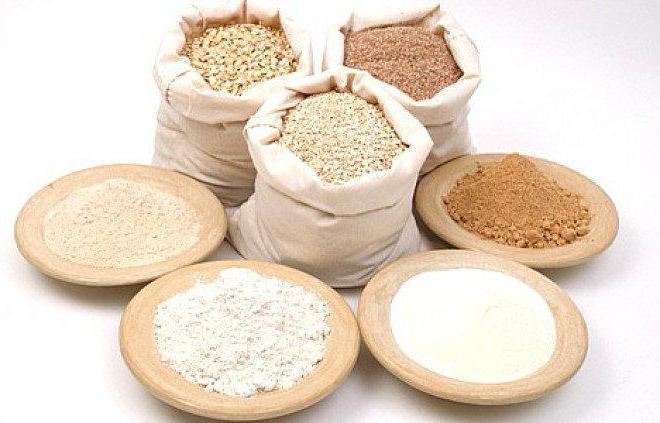

Getting rid of unwanted neighbors is extremely difficult, as beetles lay eggs all over the place. It is not enough just to throw out the bag of cereals; more drastic measures must be taken.
Beetle harm
Few people will like the Surinamese muco-eater in the apartment. What is dangerous it is, first of all, because the beetle destroys stocks of cereals. This can hit the budget of the owners decently, since the products infected with the pest are already unusable. The mucoid transfers toxic substances to products, after the use of which allergic reactions and gastrointestinal disorders may occur. For this reason, it is necessary to very carefully monitor the cleanliness of the cereals, even if you have never encountered this problem.
Fight against flour eaters in production
Eliminating the likelihood of the occurrence of flour eater is the main task of the companies in the food sector. Grain storage and production facilities are treated with special chemicals.


In addition, methods of heating, cooling and cleaning grain are used, cereals are thoroughly dried and stored at low temperatures. This helps prevent the beetle from appearing.
Quality departments monitor the purity of each batch of products sent to the counter. However, an unfair attitude to this stage of production is present and bears fruit - bugs appear in the kitchen of buyers and infect other products.
We eliminate the pest
If suddenly you find a muco-eater at home, you need to study the information on how to get rid of bugs in cereals. Fighting insects is not as easy as it might seem at first glance. They lay their eggs in completely different places and imperceptibly to the human eye. You may not see them in a bag of cereals, but they continue to breed. There is no way to instantly get rid of the bugs. However, the Surinamese flour eater can disappear from your home thanks to some methods.
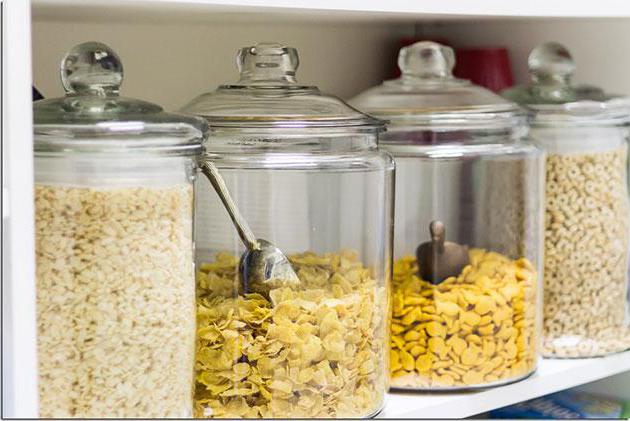

To fight you will need:
- disinfectant;
- glass jars with lids;
- garlic;
- nutmeg;
- Bay leaf.
All contaminated foods should be thrown away. Even if it seems to you that there are few bugs there, they will still continue to multiply further. It is worth reviewing all cereals, bags of flour, crackers, in a word, all bakery and cereal products. Flour is the beetle's favorite treat, and should be thrown away immediately.
It is necessary to thoroughly rinse all kitchen cabinets with a disinfectant. It is better to do this several times. Uninfected cereals should be placed in bags and left in the refrigerator. If after some time you have not noticed signs of the presence of a beetle, then you can pour the cereals into jars and close the lid tightly.
Next, you need to put bay leaves in the cabinets, and peeled garlic in the corners. Pour nutmeg onto the adhesive plaster and also spread out in the corners of the cabinets. After such procedures, bugs in the kitchen are unlikely to appear again.
Danger of contaminated food
Things are different with flour. A special sieve will help to completely get rid of excrement, husks, larvae, and adults. You can disinfect flour by heating it in the oven at a temperature of more than 50 degrees.
Note to the hostesses! The smell of lavender, citrus, lemon balm, mint repels insects. Moistening the strips of cloth that are placed throughout the kitchen with these oils will deter most grain-eating beetles.
When choosing a product, pay attention to:
- shelf life of cereals;
- the integrity of the packaging (if the package or box is damaged, there is a high probability of the presence of living creatures inside);
- the presence of moving insects inside the bag (brown or black);
- unusual impurities in cereals (can be excrement, scales, larvae and other waste products of beetles).
Almost all insects living in cereals cannot withstand temperatures of 50 and -15. It is these aspects that need to be guided when fighting bugs in the kitchen.
Helpful hints:
- almost all manufacturers of flour and cereal products undergo many treatments at the stage of production, then the products are packed in hermetically sealed packaging. It is recommended to buy just such products that have quality certificates, integral packaging;
- when buying dried fruits, semi-finished products or cereals, no one guarantees their purity. After bringing the food home, rinse it thoroughly and dry it. Roast the cereals in the oven;
- Store all supplies in well-sealed glass containers, and lids should also be made of such material.
Summing up, we can conclude that beetles are afraid of dryness, clean housewives, extreme heat and frost. Before buying, carefully examine all the supplies from the store, sort it out, dry it thoroughly, and pack it in containers.If beetles do appear in the cereals, immediately engage in their destruction.
Attention! Only today!
A kitchen cabinet can become not only a storage for cereals, but also a home for a variety of bugs. Most often, insects spoil products such as: Mucoed Surinamese, Grinder, Food moth, Flour beetle.
Have you found reddish bugs with an oblong body of 2-3 mm in the kitchen? Mucoed Surinamese has settled in your products.
His favorite haven is large granaries, but the bug also feels great at home. The main difficulty with its hatching is that it lays eggs all over the place. And even if you throw away all the contaminated products, it is highly likely that after a while the bug will appear again.
A ginger flour eater enters the house with pasta, rice, buckwheat, dried fruits and even cookies. The first step is to look through all the cereals in open bags and sacks.
Have you seen a few bugs? Rest assured - they managed to lay their eggs everywhere - on the container storing them and every available surface. You need to go through all the cabinets and drawers in the kitchen and handle them carefully.
The mucoid is the most disgusting and tenacious kitchen insect. How to remove bugs from cereals?
It is better to throw away heavily infected cereals immediately (especially flour). Products with a small number of bugs can be saved by heat treatment. It is important to review all the products stored in the kitchen - cookies, dried fruits, nuts, spices.
In any case, we place non-contaminated products in the freezer for 15 minutes, then move them into glass or plastic containers (with tight lids).
After the visible part of the bugs has been destroyed, you need to carry out a complete cleaning of the kitchen. All surfaces are washed several times with a solution of bleach; for allergy sufferers, you can choose a more gentle option (water with kitchen vinegar).
- Pest prevention
After airing the kitchen after cleaning, we end the struggle with folk remedies. We need garlic, ground nutmeg, and bay leaf.
Garlic cloves are laid out in the corners of cabinets and shelves.
Sprinkle nutmeg over all joints (you can mix it with water and pour into all the cracks). Bay leaves are attached to the cabinet walls.
A common kitchen pest is the Grinder, a light brown insect with a small head resembling a hood. Biologists distinguish two types of these insects - a grain grinder and a brownie.
Small grinder
In city apartments, both types can start. The bread grinder prefers to live in biscuits, crackers, pasta, flour. Also, this species willingly settles in any bakery products left in a place accessible to it.
The house grinder tends to multiply in loose wood, which it feeds on. He also successfully lives in books - he can often be found in library repositories.
In order to avoid the spread of these bugs in the kitchen, it is recommended to store all bread products in the refrigerator or in an airtight container (bread bins, vases with lids).
The grinder reproduces by laying nearly invisible eggs. The bugs breed in a wide temperature range (from minus 15 to plus 50 Celsius). How to remove bugs from cereals? Complex measures!
Bugs enter the room in two ways: through the cracks in the windows and with purchased products. Almost all store-bought cereals contain bug larvae, which begin to develop when they find themselves in a warm, dark room.
It is best to place jars of cereals on open shelves, illuminated by the sun. Exposure to direct sunlight will prevent insect eggs from multiplying - this will extend the shelf life of the food.
Spotting bugs is easy - just look at the food. The core of the infestation will have the highest concentration of grinders.
If you find grinders, you need to get rid of all sources of infection. It is best to send cereals with bugs and larvae down the drain. Cereals, whose contamination seems to be controversial, can be processed at different temperatures.
First, they need to be placed in the freezer for a day, then - fry in the oven for 10-15 minutes at medium temperature.
In the kitchen, it is necessary to thoroughly wash every cabinet, shelf, and drawer with a solution containing bleach in order to kill the delayed larvae.
All wooden cracks through which insects can move will have to be sealed with sealant.
The interior of the cabinets after processing can be protected with brown (sodium tetrabonate). Boric acid salt can be purchased at a regular pharmacy.
Prophylaxis
To eliminate the appearance of beetles, you need to take some preventive measures. It is not enough just to hold the cereal bags in the refrigerator. It is necessary to make bags from canvas material, which are boiled for half an hour in a saline solution. Then dry them and iron them with an iron. If you store cereals in such bags, then you can protect yourself from the appearance of the mucoed. You can also put purchased cereals in the freezer for several days.
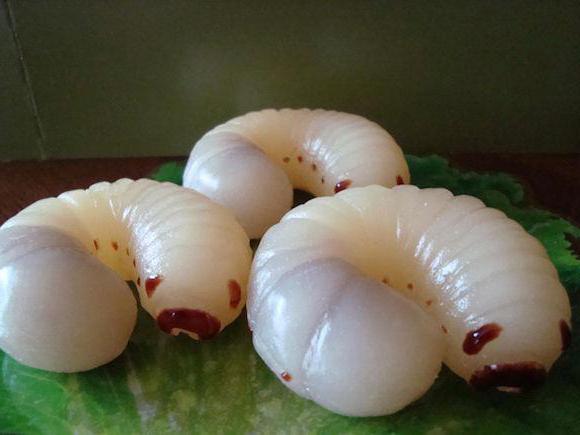

If you have bugs in the kitchen, then you should not despair, thinking that you are an unclean housewife. Mucoeda can be brought on clothes or with cereals from the store, and this is not a single drop of human fault. The main thing is to know how to get rid of bugs in cereals, and to act immediately.
Clean kitchen areas regularly, treat with disinfectants, check all products carefully.
Video
The author of this video offers some tips for dealing with Surinamese flour eaters that appear in malt. However, he believes that contaminated cereals can also be used to brew beer. In his opinion, this does not change the taste and quality of the drink.
The author of the following video suggests protecting yourself from the reappearance of the short-wooded mucoed by storing bulk products in closed glass jars, inside which you should put mint chewing gum.
In this video, it is proposed to destroy the Surinamese muco-eater using warm exposure. Namely, by heating the affected food in a microwave oven.

